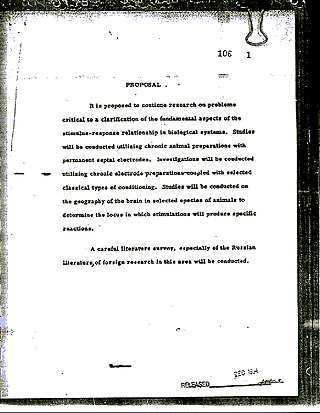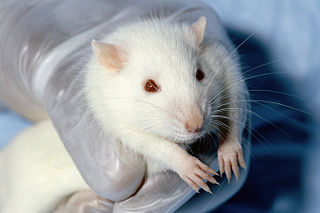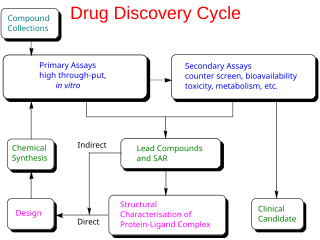
The United States Food and Drug Administration is a federal agency of the Department of Health and Human Services. The FDA is responsible for protecting and promoting public health through the control and supervision of food safety, tobacco products, caffeine products, dietary supplements, prescription and over-the-counter pharmaceutical drugs (medications), vaccines, biopharmaceuticals, blood transfusions, medical devices, electromagnetic radiation emitting devices (ERED), cosmetics, animal foods & feed and veterinary products.

Toxicology is a scientific discipline, overlapping with biology, chemistry, pharmacology, and medicine, that involves the study of the adverse effects of chemical substances on living organisms and the practice of diagnosing and treating exposures to toxins and toxicants. The relationship between dose and its effects on the exposed organism is of high significance in toxicology. Factors that influence chemical toxicity include the dosage, duration of exposure, route of exposure, species, age, sex, and environment. Toxicologists are experts on poisons and poisoning. There is a movement for evidence-based toxicology as part of the larger movement towards evidence-based practices. Toxicology is currently contributing to the field of cancer research, since some toxins can be used as drugs for killing tumor cells. One prime example of this is ribosome-inactivating proteins, tested in the treatment of leukemia.

Project MKUltra was a human experimentation program designed and undertaken by the U.S. Central Intelligence Agency (CIA) to develop procedures and identify drugs that could be used during interrogations to weaken individuals and force confessions through brainwashing and psychological torture. The term MKUltra is a CIA cryptonym: "MK" is an arbitrary prefix standing for the Office of Technical Service and "Ultra" is an arbitrary word out of a dictionary to denominate this project. The program has been widely condemned as a violation of individual rights and an example of the CIA’s abuse of power, with critics highlighting its disregard for consent and its corrosive impact on democratic principles.
Incapacitating agent is a chemical or biological agent which renders a person unable to harm themselves or others, regardless of consciousness.

Animal testing, also known as animal experimentation, animal research, and in vivo testing, is the use of non-human animals, such as model organisms, in experiments that seek to control the variables that affect the behavior or biological system under study. This approach can be contrasted with field studies in which animals are observed in their natural environments or habitats. Experimental research with animals is usually conducted in universities, medical schools, pharmaceutical companies, defense establishments, and commercial facilities that provide animal-testing services to the industry. The focus of animal testing varies on a continuum from pure research, focusing on developing fundamental knowledge of an organism, to applied research, which may focus on answering some questions of great practical importance, such as finding a cure for a disease. Examples of applied research include testing disease treatments, breeding, defense research, and toxicology, including cosmetics testing. In education, animal testing is sometimes a component of biology or psychology courses.

Driving under the influence (DUI) is the offense of driving, operating, or being in control of a vehicle while impaired by alcohol or drugs, to a level that renders the driver incapable of operating a motor vehicle safely. Multiple other terms are used for the offense in various jurisdictions.
Project Artichoke was a project developed and enacted by the United States Central Intelligence Agency (CIA) for the purpose of researching methods of interrogation. Project Artichoke was succeeded by Project MKUltra, which began in 1953.
Animal euthanasia is the act of killing an animal humanely, most commonly with injectable drugs. Reasons for euthanasia include incurable conditions or diseases, lack of resources to continue supporting the animal, or laboratory test procedures. Euthanasia methods are designed to cause minimal pain and distress. Euthanasia is distinct from animal slaughter and pest control.
Project Chatter was a United States Navy program beginning in the fall of 1947 focusing on the identification and testing of drugs in interrogations and the recruitment of agents. Their search included laboratory experiments on both animal and human subjects. The program operated under the direction of Charles Savage of the Naval Medical Research Institute, Bethesda, Maryland, from 1947 to 1953. The project was geared toward identifying agents both synthetic and natural that were effective during interrogation, as well as testing possible treatments for depression. The project was centered on, but not restricted to, the use of anabasine, scopolamine and mescaline. It was the first U.S. government project in which lysergic acid diethylamide (LSD-25) was used on human subjects. The Navy ended the project in 1953 when its experiments were merged into Project MKULTRA.

A somatic cell count (SCC) is a cell count of somatic cells in a fluid specimen, usually milk. In dairying, the SCC is an indicator of the quality of milk—specifically, its low likeliness to contain harmful bacteria, and thus its high food safety. White blood cells (leukocytes) constitute the majority of somatic cells in question. The number of somatic cells increases in response to pathogenic bacteria like Staphylococcus aureus, a cause of mastitis. The SCC is quantified as cells per milliliter. General agreement rests on a reference range of less than 100,000 cells/mL for uninfected cows and greater than 250,000 for cows infected with significant pathogen levels. Several tests like the PortaSCC milk test and The California mastitis test provide a cow-side measure of somatic cell count. The somatic cell count in the milk also increases after calving when colostrum is produced.

Drug development is the process of bringing a new pharmaceutical drug to the market once a lead compound has been identified through the process of drug discovery. It includes preclinical research on microorganisms and animals, filing for regulatory status, such as via the United States Food and Drug Administration for an investigational new drug to initiate clinical trials on humans, and may include the step of obtaining regulatory approval with a new drug application to market the drug. The entire process—from concept through preclinical testing in the laboratory to clinical trial development, including Phase I–III trials—to approved vaccine or drug typically takes more than a decade.

Clenbuterol is a sympathomimetic amine used by sufferers of breathing disorders as a decongestant and bronchodilator. People with chronic breathing disorders such as asthma use this as a bronchodilator to make breathing easier. It is most commonly available as the hydrochloride salt, clenbuterol hydrochloride.

The Centre for Cellular and Molecular Biology or CCMB is an Indian fundamental life science research establishment located in Hyderabad that operates under the aegis of the Council of Scientific and Industrial Research. CCMB is a designated "Centre of Excellence" by the Global Molecular and Cell Biology Network, UNESCO.

Epitestosterone, or isotestosterone, also known as 17α-testosterone or as androst-4-en-17α-ol-3-one, is an endogenous steroid and an epimer of the androgen sex hormone testosterone. It is a weak competitive antagonist of the androgen receptor (AR) and a potent 5α-reductase inhibitor.

Experiments involving non-human primates (NHPs) include toxicity testing for medical and non-medical substances; studies of infectious disease, such as HIV and hepatitis; neurological studies; behavior and cognition; reproduction; genetics; and xenotransplantation. Around 65,000 NHPs are used every year in the United States, and around 7,000 across the European Union. Most are purpose-bred, while some are caught in the wild.

Alternatives to animal testing are the development and implementation of test methods that avoid the use of live animals. There is widespread agreement that a reduction in the number of animals used and the refinement of testing to reduce suffering should be important goals for the industries involved. Two major alternatives to in vivo animal testing are in vitro cell culture techniques and in silico computer simulation; however, some claim they are not true alternatives because simulations use data from prior animal experiments and cell cultures often require animal derived products, such as serum or cells. Others say that they cannot replace animals completely as they are unlikely to ever provide enough information about the complex interactions of living systems.

The University of Minnesota runs a number of studies involving non-human primates, most notably research into drug addiction. The studies have attracted the attention of local and national animal rights groups, most especially the drug addiction studies of Marilyn Carroll, which she performs on primates, rats, and mice.

Animal testing regulations are guidelines that permit and control the use of non-human animals for scientific experimentation. They vary greatly around the world, but most governments aim to control the number of times individual animals may be used; the overall numbers used; and the degree of pain that may be inflicted without anesthetic.
An Emergency Use Authorization (EUA) in the United States is an authorization granted to the Food and Drug Administration (FDA) under sections of the Federal Food, Drug, and Cosmetic Act as added to and amended by various Acts of Congress, including by the Pandemic and All-Hazards Preparedness Reauthorization Act of 2013 (PAHPRA), as codified by 21 U.S.C. § 360bbb-3, to allow the use of a drug prior to approval. It does not constitute approval of the drug in the full statutory meaning of the term, but instead authorizes the FDA to facilitate availability of an unapproved product, or an unapproved use of an approved product, during a declared state of emergency from one of several agencies or of a "material threat" by the Secretary of Homeland Security.
Rise for Animals is a national, registered 501(c)(3) nonprofit animal rights organization which aims to end nonhuman animal experimentation. It has been described as "one of the oldest and wealthiest anti-vivisection organizations in the United States".









